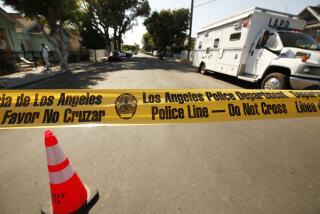Can we make Walmarts and other public spaces safer? Mass shootings show vulnerable ‘soft targets’

- Share via
At a Temecula Walmart, police on Monday responded to reports of an armed shoplifter.
But on social media, concerned shoppers worried that something much worse was going on, sending panicked messages on Twitter and Facebook and warning others to stay away from the store.
One Twitter user wrote, “A coward is trying to be a copycat from this weekend.”
No one was injured, and the Riverside County Sheriff’s Department found that the weapon in question was a BB gun.
But the incident spoke to the heightened tensions after back-to-back shootings in El Paso and Dayton, Ohio, nearly a week after communities were left reeling by a shooting at the Garlic Festival in nearby Gilroy.
The shootings all occurred in public places — a Walmart, a popular bar and a famous food festival. It left both law enforcement officials and security experts debating what more could be done to better protect these venues from attacks.
“Soft targets” have long been of concern to counter-terrorism officials, even as venues have increased security and added metal detectors and even bomb detection equipment. But it’s clear those measures cannot prevent a gunman hellbent on killing.
There is also more discussion about whether there is more that officials can do to detect red flags on social media, a subject that has raised privacy concerns.
Michael Downing, the former deputy chief of the Los Angeles police counter-terrorism bureau and current chief security officer for the Oak View Group/Prevent Advisors, said that lone shooters were typically choosing soft targets without traditional security apparatus. And the focus of security is now about being “first preventers rather than first responders.”
But the former top counter-terrorism cop who helps analyze security risks said such efforts to detect and prevent assailants can go only so far as a wide culture shift on guns and ammunition is needed.
“There are always things you can do to protect a target further — well-trained staff, counter-surveillance and other things to identify a potential threat on social media,” Downing said. “Being a lone wolf or lone rat makes these shooters extremely hard to detect. You can look at analytics that identify likely suspects. But it is a question of politics.”
Security experts say restricting weapons, ammunition and putting aside privacy concerns may be the most crucial prevention tactics to such attacks, and that may make those on the right and left of the political spectrum unhappy.
But all the preventive know-how can only do so much.
“I think we are fed up with hearing about thoughts and prayers when we have shooters like in Ohio with 100-round weapons,” he said.
Monique Carrillo, 29, is all too aware that a mass shooting can happen without warning. When she entered the Walmart in Torrance on Monday morning, she thought about places where she and her baby daughter could hide in the event of such an occurrence.
“I did think about where the exits were when I got into the store and tried to be aware of my surroundings,” she said. “I have to be aware now, especially with my daughter.”
Carrillo of Hawthorne said the shooting at a Walmart in El Paso made her think twice before entering the store. Lester L., 69, however, was undeterred.
“What’s going to happen is going to happen,” said Lester, who declined to give his last name.
The Compton resident said the country must work toward a solution to end gun violence. Until then, people can’t let fear stop them from going about with their days.
The longtime customer noted the effect of President Trump’s rhetoric.
“The way Trump is talking ain’t helping,” he said. “We’ve got work to do.”
For Downing, that work means extending restrictions beyond genuinely military-style weapons with ammunition feeds.
“We need to control ammunition distribution and make policy changes,” he said.
Downing said he was organizing a security conference on Sept. 11 in New York and the agenda was changing. “How to identify the domestic terror threat in America” is now a central topic.
Many large organizations, companies and operators of gathering places are making constant threat assessments based on social media monitoring and cyberspace activity, Downing said, pointing to an event like the 2017 bombing that occurred at the Ariana Grande concert in England.
“Could red flags have been seen?” he said.
Downing said event organizers are now monitoring social media geographically, keeping tabs on those at or near concerts and sporting events. There has also been a shift in thinking after the Sept. 11 and Columbine High School attacks that stresses a proactive model of prevention that in part relies on the eyes and ears of the public and intelligence.
“Dayton and El Paso shows you cannot rest on your laurels,” he said.
But how is that type of threat predicted?
Downing said the Los Angeles Police Department threat assessment and mental health evaluations regularly track potentially threatening individuals by sending out mental health professionals to assess people and ensure they don’t have the means to obtain a weapon.
Finding lone wolf terrorists domestically is nearly impossible, said Charles “Sid” Heal, a former Los Angeles County sheriff’s commander who has been involved in counter-terrorism efforts locally and overseas, including in Somalia with the U.S. Marine Corps.
“These individuals are the ones we fear as terrorists. The lone wolves act on their own, they don’t make contact with others. They make all their plans in their head. All the programs in the world don’t detect these people,” he said. “A decade or more ago, the FBI identified them as among the most serious threats.”
L.A. County Sheriff Alex Villanueva said his department was “constantly evaluating” potential threats on a minute-by-minute basis. The challenge, he said, is obvious soft targets.
Villanueva says his deputies know they may have to act alone if an attack occurs.
“That is a tough call,” he said. “It takes a lot of guts to do that, but we expect the deputy to do that.”
The sheriff said people needed to be prepared to escape a dangerous situation.
“We have lost some of our innocence,” he said.
Heal says cyberspace is one of the few places investigators can search for potential assailants, as they tend to seek out like-minded people in the dark holes of 8chan and other communities.
“While we can monitor the very public areas of discussion on social media, we cannot delve into the more personal communications because of privacy concerns,” he said.
But counter-terrorism investigators are increasingly in conflict with privacy advocates.
“Facial recognition and license plate readers are often the only options for tracking a potential suspect,” Heal said. “San Francisco‘s recent decision to forbid facial recognition technology has left a gap that means a threat may not be as easily tracked.”
Mass shooters were able to evade gun and ammunition measures set in place in the states they lived in, he added.
“I am not sure you can keep guns out of these people’s hands. We couldn’t keep the rifle away from the gunman in Gilroy,” Heal said. “People like this individual are going to get their guns.” While the talk is about rifles, he said, the reality is that “68% of these attacks occur with handguns.”
Although the threat of the unseen remains, many refuse to be overtaken by fear.
Laura B., 50, was at the Torrance Walmart when the shooting occurred miles away in Texas. She shopped alongside families who, like many of those who died in El Paso, were picking up back-to-school supplies. She didn’t learn about the attack until she got home later. When she returned the next day to exchange an item, she found the store was packed.
“That was a little scary,” said Laura, who declined to give her last name. But she stayed put, as many others did.
A Walmart representative was not immediately available to comment on whether the Southern California store had increased security. And additional precautions, if any, were not obviously visible to shoppers Monday.
One store employee noticed a dip in foot traffic Sunday morning. She said she believed the El Paso shooting might have been the cause. But by Sunday afternoon, the store appeared to be at normal capacity.
More to Read
Sign up for Essential California
The most important California stories and recommendations in your inbox every morning.
You may occasionally receive promotional content from the Los Angeles Times.












